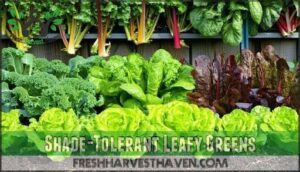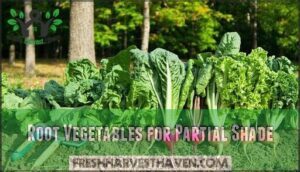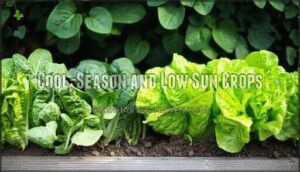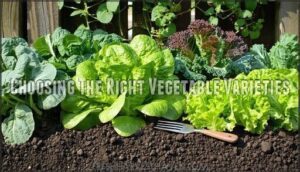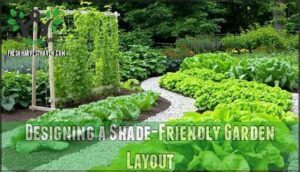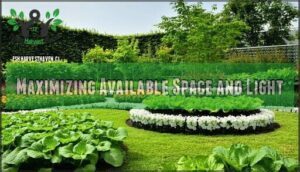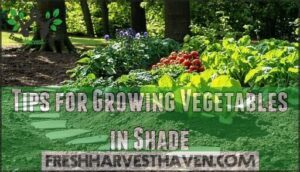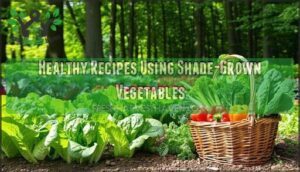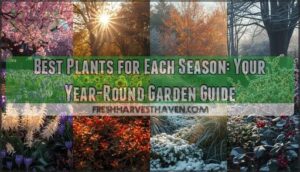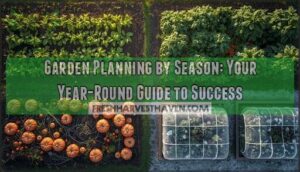This site is supported by our readers. We may earn a commission, at no cost to you, if you purchase through links.
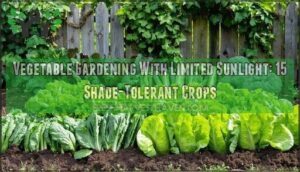
Leafy greens like spinach, lettuce, and kale thrive in filtered light and often taste sweeter than their sun-stressed counterparts. Root vegetables such as carrots and beets also perform well in these conditions.
Cool-season crops like peas and broccoli benefit from protection against intense afternoon heat. The secret lies in understanding which plants tolerate shade and preparing your soil properly with organic matter to support healthy growth in lower-light conditions.
Table Of Contents
- Key Takeaways
- Assessing Sunlight Levels in Your Garden
- Best Vegetables for Limited Sunlight
- Planning a Productive Shade Garden
- Tips for Growing Vegetables in Shade
- Healthy Recipes Using Shade-Grown Vegetables
- Frequently Asked Questions (FAQs)
- What vegetable needs the least amount of sunlight?
- Can a vegetable garden grow in the shade?
- What happens if vegetables dont get enough sun?
- What vegetable grows best in shade?
- Can you grow vegetables in full shade?
- Can vegetables grow in partial sunlight?
- Can you grow vegetables with less sunlight or more shade?
- Can vegetables grow in partial shade?
- Do vegetables need direct sunlight?
- Which vegetables grow in shade?
- Conclusion
Key Takeaways
- You don’t need full sun to grow productive vegetables – many crops actually thrive in partial shade with just 3-4 hours of daily sunlight and often taste better than their sun-stressed counterparts.
- Focus on leafy greens like spinach, lettuce, and kale, plus root vegetables such as carrots and beets, which all perform exceptionally well in filtered light conditions.
- You’ll need to measure your garden’s light patterns accurately and prepare soil with organic matter since shaded areas retain moisture longer and require different watering schedules.
- Strategic garden planning with vertical structures, reflective materials, and proper plant placement can transform your shadiest spots into continuous harvest zones for cool-season crops.
Assessing Sunlight Levels in Your Garden
Before you can choose the right shade-tolerant vegetables, you’ll need to accurately measure how much sunlight your garden receives throughout the day.
Most gardeners are surprised to learn that what looks like "full shade" often gets 2-4 hours of filtered sunlight, which opens up many more growing possibilities than you’d expect.
Your garden’s shadowy corners hide more growing potential than most people realize
How to Measure Light Intensity
Understanding your garden’s light levels starts with proper measurement tools and techniques. You’ll need reliable methods to assess whether areas receive full sun or partial shade for your shade-tolerant vegetable garden.
Here are four essential measurement approaches:
- Light Meter Tools – Digital photometers provide precise lux readings for accurate garden illumination assessment
- Sunlight Tracking – Monitor specific spots hourly from dawn to dusk over several days
- Photoperiod Measurement – Count direct sunlight hours each location receives throughout growing season
- Shade Analysis – Document shadow patterns cast by buildings, trees, and structures affecting leafy greens areas.
To improve growth, it’s vital to understand the sunlight requirements for various plants.
Factors That Affect Garden Light
Several elements shape light intensity in your vegetable garden. Buildings and trees create shade patterns that shift throughout the day as the sun angle changes. Your garden’s orientation determines whether areas receive full sun or partial shade.
Soil temperature drops in shadier spots, affecting root development. Day length varies seasonally, impacting growth cycles.
Leafy greens actually prefer these cooler, shadier conditions over intense sunlight.
Identifying Partial Shade Areas
Once you’ve mapped your garden’s light patterns, you’ll need to pinpoint partial shade zones. These areas receive 3-6 hours of filtered sunlight daily, perfect for shade-tolerant leafy greens.
Look for spots with morning sun and afternoon shadows, or areas with light filtering through tree canopies.
Your vegetable garden’s orientation matters—north-facing beds naturally create partial shade conditions ideal for growing shade-tolerant crops.
Best Vegetables for Limited Sunlight
You’ll find that certain vegetables actually prefer less sunlight and can outperform their full-sun counterparts in shaded areas. Think of leafy greens like spinach and lettuce as the introverts of the vegetable world – they thrive in cooler, partially shaded spots where intense sunlight would stress them out.
Shade-Tolerant Leafy Greens
Now that you’ve mapped your garden’s light patterns, leafy green varieties shine as your shade-tolerant champions. These leafy greens thrive with just 3-4 hours of daily sunlight, making gardening in partial shade surprisingly productive. Lettuce, spinach, and kale adapt beautifully to growing vegetables in shade conditions. Swiss chard tolerates 30-45% shade cloth while maintaining year-round harvests.
Consider vertical gardening systems and greenhouse growing techniques to boost your leafy vegetables production in challenging spots. Understanding soil moisture levels is essential for maintaining a healthy shade garden.
Root Vegetables for Partial Shade
Root vegetables break free from the full-sun myth that holds many gardeners back. Shade tolerant beets thrive in partial shade, producing sweet, earthy roots with minimal fuss. Partial shade carrots develop slowly but reward patience with concentrated flavor.
Your root crop selection should focus on these shade-tolerant champions that adapt to vegetable shade requirements. Root vegetable yields actually improve in cooler, filtered light conditions where soil stays moist longer.
Cool-Season and Low Sun Crops
Cool season crops thrive when temperatures drop and daylight fades. These shade tolerant plants actually prefer partial shade gardening conditions over scorching summer heat. Cold climate farming becomes easier with these leafy vegetables that flourish in cooler weather:
- Spinach grows vigorously in partial shade during spring and fall months
- Swiss chard produces colorful stems while tolerating low sun conditions
- Lettuce varieties stay crisp longer without bolting in shadier spots
- Arugula develops its signature peppery flavor in cool, shaded environments
Planning a Productive Shade Garden
You can’t just scatter seeds in your shady backyard and hope for the best. Success with shade gardening requires strategic planning that matches your low-light conditions with the right vegetable varieties and garden layout.
Choosing The Right Vegetable Varieties
Smart vegetable selection transforms your shady garden into a productive powerhouse. Focus on leafy greens like spinach and kale that thrive in partial shade conditions. Choose compact varieties of lettuce and chard for maximum shade tolerance.
Consider your soil preferences when selecting crops—some shade-tolerant vegetables prefer well-draining conditions while others tolerate moisture. Plan crop rotation with these hardy variety choices to maintain soil health year-round.
Designing a Shade-Friendly Garden Layout
Once you’ve selected the right varieties, your shade garden mapping becomes the foundation for success. Strategic placement transforms limited sunlight into productive growing space. Think of your garden as a theater where each plant needs its spotlight moment.
- Vertical Gardening Solutions: Install trellises on the south side for climbing shade tolerant plants like peas, creating natural microclimates below for leafy greens.
- Layered Plant Positioning: Place taller crops northward, medium herbs in center rows, and low-growing lettuce toward the south edge of partial shade areas.
- Pathway Integration: Design 30-inch walkways between beds to prevent soil compaction while accessing your edible landscape efficiently.
Understanding shade garden principles is vital for maximizing yields in areas with limited sunlight.
Maximizing Available Space and Light
Transform your shade garden into a productive powerhouse through strategic Space Optimization and Light Reflection techniques. Garden Mapping reveals where partial shade transitions to full sun, guiding plant placement. Vertical Gardening structures increase growing area while improving light penetration to shade-tolerant leafy greens below. Effective use of shade garden kits can improve the overall growth and health of plants in such environments.
| Technique | Implementation |
|---|---|
| Mirror panels | Redirect sunlight to darker corners |
| White mulch | Reflects available light upward |
| Tiered planting | Tall crops behind, short ones forward |
| Reflective surfaces | Use aluminum foil or light-colored stones |
Tips for Growing Vegetables in Shade
Growing vegetables in shade requires specific techniques that work with reduced light conditions rather than against them.
You’ll need to focus on soil enrichment with organic matter and proper moisture management since shaded areas often retain water longer than sunny spots.
Soil Preparation and Nutrient Management
Before planting your shade-tolerant vegetables, conduct soil testing to determine pH levels and nutrient content. Shady areas often have acidic soil that needs pH balancing with lime.
Create compost from kitchen scraps to boost organic matter and support nutrient cycling. Apply organic fertilizers specifically formulated for leafy vegetables, as these nutrient-rich crops require higher nitrogen levels for ideal vegetable nutrition and fiber production.
Watering and Mulching in Shady Spots
Shady spots retain moisture longer than full sun areas, making watering timing critical. You’ll need to adjust your irrigation schedule since shade-tolerant plants in partial shade require less frequent but deeper watering. Monitor shade soil moisture levels closely to prevent overwatering.
- Use organic mulching materials like shredded leaves or straw to retain moisture
- Apply 2-3 inches of mulch around shade-tolerant vegetables for water conservation
- Check soil moisture 2 inches deep before watering your shady spot irrigation
- Water early morning to reduce fungal disease risk in humid shade conditions
- Choose mulch types that decompose slowly like wood chips for strawbale garden areas
Using Shade Cloth and Garden Structures
Strategic garden structures can transform partial shade areas into productive growing spaces. You’ll optimize light penetration using reflective materials and vertical gardening techniques for shade tolerant plants. Understanding the best shade crops is essential for a successful harvest.
| Structure Type | Best Application |
|---|---|
| Shade Cloth Materials | Filter harsh sunlight for delicate crops |
| Garden Canopy Systems | Create controlled microclimates |
| Vertical Gardening | Optimize space in strawbale garden setups |
| Reflective Panels | Redirect available light to ShadeTolerant varieties |
Healthy Recipes Using Shade-Grown Vegetables
You’ll discover that shade-grown vegetables like spinach, kale, and Swiss chard create surprisingly flavorful dishes that pack serious nutritional value.
These nutrient-dense crops transform into fresh salads, hearty soups, and colorful stir-fries that’ll make you forget they grew in your garden’s shadiest spots.
Fresh Salads and Leafy Green Dishes
Your shade-tolerant leafy greens shine brightest in fresh salad recipes and green smoothies. These nutrient-packed crops from partial shade gardens need minimal vegetable prep but maximum flavor impact. Spinach, kale, and lettuce varieties transform simple meals into powerhouse dishes with healthy dressings.
- Mix arugula and spinach with lemon vinaigrette for peppery salads
- Blend kale into green smoothies with fruits to mask bitterness
- Create lettuce wraps using butter lettuce for low-carb meals
- Massage kale leaves with olive oil before adding to grain bowls
Roasted and Stir-Fried Vegetable Ideas
Heat transforms your shade-grown vegetables into nutrient-rich masterpieces. Roasted vegetables like carrots and beets develop caramelized edges at 425°F, while stir fry recipes showcase quick-cooking greens with garlic and ginger.
Your vegetable medley benefits from proper roasting techniques – cut uniformly and don’t overcrowd pans. Stir fry sauces made from soy sauce and sesame oil complement fiber-rich foods perfectly.
Nutritious Soups for Seasonal Eating
Beyond stir-fries, your shade-grown vegetables shine in nutrient-rich winter stews and healthy simmering soups. These seasonal vegetables create warming meals packed with fiber and essential nutrients. Homemade vegetable broth transforms your harvest into comfort food that nourishes your body through colder months. Using hearty soup recipes can help you create delicious and comforting meals with your shade-grown vegetables.
- Hearty root vegetable soup – Combine carrots, potatoes, and turnips with fresh herbs
- Creamy leafy green bisque – Blend kale, spinach, or chard with seasonal ingredients
- Classic minestrone – Mix beans, tomatoes, and whatever vegetables you’ve grown
- Asian-inspired broth – Use bok choy, mushrooms, and ginger for immune support
- Rustic cabbage stew – Slow-cook with onions and garlic for maximum flavor
Frequently Asked Questions (FAQs)
What vegetable needs the least amount of sunlight?
Like a green umbrella, lettuce thrives in partial shade conditions. Leafy greens need just two to four hours of sunlight daily, making them perfect low-light performers for your garden.
Can a vegetable garden grow in the shade?
You absolutely can grow vegetables in shade! Many veggies can tolerate partial shade; a few even appreciate it! With 3-4 hours of light, stick to greens like lettuce, spinach, Swiss chard, collards, and endive.
What happens if vegetables dont get enough sun?
When your plants are in the dark, they’re basically starving. Without enough sunlight, you’ll see light green foliage, poor yields, and spindly growth as plants stretch desperately toward available light sources.
What vegetable grows best in shade?
Leafy greens like lettuce, spinach, and Swiss chard perform best in shade, requiring only 3-4 hours of sunlight daily.
Root vegetables such as beets, radishes, and turnips also thrive with minimal light.
Can you grow vegetables in full shade?
You can’t successfully grow vegetables in full shade, but many tolerate partial shade. Leafy greens like lettuce and spinach handle low light better than fruiting vegetables, which need more sun.
Can vegetables grow in partial sunlight?
Picture dappled sunlight filtering through your garden canopy. Yes, you can grow vegetables in partial sunlight with 3-6 hours of exposure daily.
Leafy greens like lettuce, herbs, and root vegetables thrive in these conditions.
Can you grow vegetables with less sunlight or more shade?
You can successfully grow vegetables with just 3-4 hours of sunlight daily. Leafy vegetables like spinach, kale, and chard thrive in partial shade, while root crops including beets and carrots also tolerate less sun.
Can vegetables grow in partial shade?
You’re breaking garden rules here! Many vegetables thrive in partial shade with just 3-4 hours of sunlight. Lettuce, beets, radishes, broccoli, and cauliflower grow successfully in shadier conditions.
Do vegetables need direct sunlight?
Most vegetables don’t require direct sunlight to thrive. You’ll find leafy greens, herbs, and root vegetables flourish in partial shade conditions with just 3-4 hours of daily sun exposure.
Which vegetables grow in shade?
Like shadows dancing between skyscrapers, shade-tolerant vegetables thrive where sunlight’s scarce. You’ll find leafy greens like spinach, kale, lettuce, arugula and root vegetables like beets, carrots, turnips flourishing in partial shade conditions.
Conclusion
Like a skilled conductor orchestrating nature’s symphony, you can transform any partially shaded space into a thriving food production area. Vegetable gardening with limited sunlight isn’t a compromise—it’s an opportunity to grow tender, flavorful crops that often surpass their sun-baked counterparts.
Your shade garden will reward you with continuous harvests of leafy greens, root vegetables, and cool-season favorites. Remember that proper soil preparation and variety selection matter more than perfect sun exposure.
Start your shade-tolerant vegetable garden today and discover how productive limited sunlight gardening can be.
- https://getbusygardening.com/growing-vegetables-part-shade/
- https://cals.cornell.edu/school-integrative-plant-science/school-sections/horticulture-section/outreach-and-extension/pandemic-vegetable-gardening/pandemic-vegetable-gardening-2020-archive/sunlight-key-great-vegetables
- https://bonnieplants.com/blogs/garden-fundamentals/vegetables-grow-shade
- https://www.swansonsnursery.com/blog/shade-tolerant-vegetables-herbs
- https://www.cindyheathwrites.com/lets-eat/what-is-the-magic-amount-of-sunlight-to-grow-maximum-veggies

